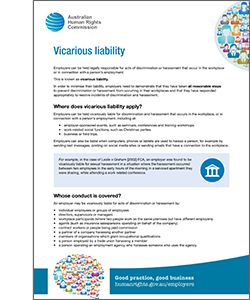Vicarious liability
Vicarious liability PDF (716 KB)
Vicarious liability Word (116 KB)
Employers can be held legally responsible for acts of discrimination or harassment that occur in the workplace or in connection with a person’s employment.
This is known as vicarious liability.
In order to minimise their liability, employers need to demonstrate that they have taken all reasonable steps to prevent discrimination or harassment from occurring in their workplaces and that they have responded appropriately to resolve incidents of discrimination and harassment.
Where does vicarious liability apply?
Employers can be held vicariously liable for discrimination and harassment that occurs in the workplace, or in connection with a person’s employment, including at:
- employer-sponsored events, such as seminars, conferences and training workshops
- work-related social functions, such as Christmas parties
- business or field trips.
Employers can also be liable when computers, phones or tablets are used to harass a person; for example by sending text messages, posting on social media sites or sending emails that have a connection to the workplace.
For example, in the case of Leslie v Graham [2002] FCA, an employer was found to be vicariously liable for sexual harassment in a situation where the harassment occurred between two employees in the early hours of the morning in a serviced apartment they were sharing, while attending a work related conference.
Whose conduct is covered?
An employer may be vicariously liable for acts of discrimination or harassment by:
- individual employees or groups of employees
- directors, supervisors or managers
- workplace participants (where two people work on the same premises but have different employers)
- agents (such as insurance salespersons operating on behalf of the company)
- contract workers or people being paid commission
- a partner of a company harassing another partner
- members of organisations which grant occupational qualifications
- a person employed by a trade union harassing a member
- a person operating an employment agency who harasses someone who uses the agency.
For example, in the case of Gama v Qantas Airways Ltd (No 2) [2006] FMCA, Qantas was found to be vicariously liable for racial discrimination in a situation where racial discriminatory remarks in the workplace were made by, or in the presence of, a supervisor and were therefore considered to be condoned by the employer.
What is the liability of the individuals involved?
Individuals who harass, bully or discriminate against others in the workplace are directly liable for their own actions.
However, if an employer can not demonstrate that they have taken ‘all reasonable steps’ to prevent the discrimination or harassment from occurring, then both the individual and the employer could be jointly liable for the behaviour.
What does ‘all reasonable steps’ mean?
Anti-discrimination laws do not provide a clear-cut definition of ‘all reasonable steps’ because what may be ‘reasonable’ for a large corporation may not be ‘reasonable’ for a small business. Instead, it is worked out on a case-by-case basis.
The key point is that employers must take active steps to minimise the risk that discrimination or harassment can occur in their workplace.
When deciding what level of preventative action is reasonable, an employer should consider:
- the size, structure and available resources of the organisation
- the type and nature of the work undertaken by the organisation
- the mix of employees in the workplace, including women, young and older workers, people with disabilities and people from culturally and linguistically diverse backgrounds
- the culture of the workplace
- previous incidents of workplace discrimination and harassment
- levels of employee supervision
- relevant provisions in industrial awards or agreements, and
- any other relevant factors, such as working hours, geographic isolation, live-in arrangements or duties which require working in close physical proximity with others.
Steps to prevent workplace discrimination and harassment
-
Have a strong and clear policy on discrimination and harassment and make sure it is communicated effectively in the workplace (see the Workplace discrimination and harassment policy template).
-
Ensure there is clear, unambiguous and visible support from senior management for the policy.
-
Develop a procedure to respond to internal complaints about discrimination and harassment in a fair, timely and effective way (see Good practice guidelines for internal complaint processes).
-
Treat all complaints seriously and investigate them promptly.
-
Appoint and train harassment contact officers of both sexes with whom employees can discuss any questions, concerns or complaints about discrimination and harassment.
-
Ensure that all staff are aware of the organisation’s policies and procedures regarding discrimination and harassment.
-
Regularly review these policies and procedures to ensure they are up to date with the law and best practice, and ensure that any updates are clearly communicated to staff.
-
Provide regular training to staff to ensure they understand their workplace responsibilities and to identify and respond to incidents of discrimination and harassment.
-
Provide information about external agencies, such as the Australian Human Rights Commission, that can provide advice about dealing with complaints of discrimination and harassment.
-
Monitor the workplace environment and culture, using processes such as confidential staff surveys.
-
Ensure that managers and supervisors are trained effectively to understand their responsibilities to proactively identify and deal with discrimination and harassment issues. Check that they are fulfilling these responsibilities through regular performance appraisals.
-
Regularly monitor strategies to prevent discrimination and harassment to ensure they are working effectively.
For more information, see the fact sheet, Ten steps you can take to create a fair and productive workplace.
These documents provide general information only on the subject matter covered. It is not intended, nor should it be relied on, as a substitute for legal or other professional advice. If required, it is recommended that the reader obtain independent legal advice. The information contained in these documents may be amended from time to time.


